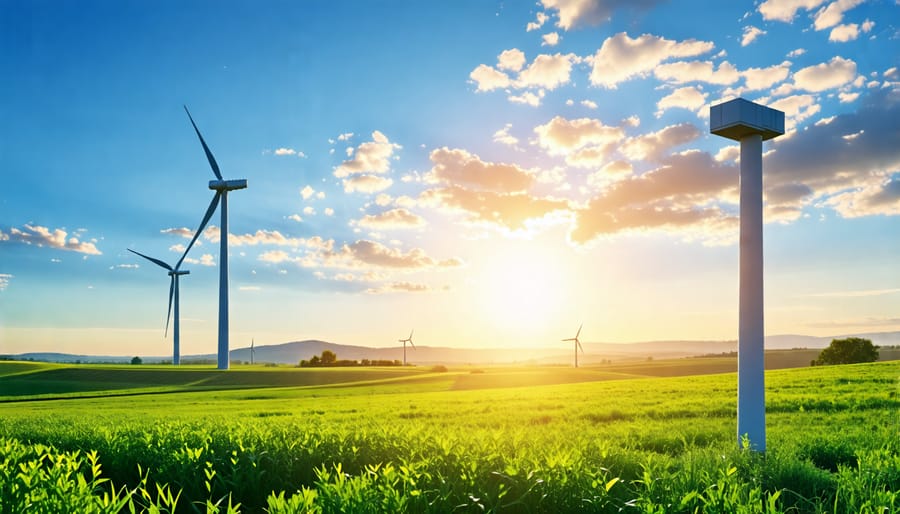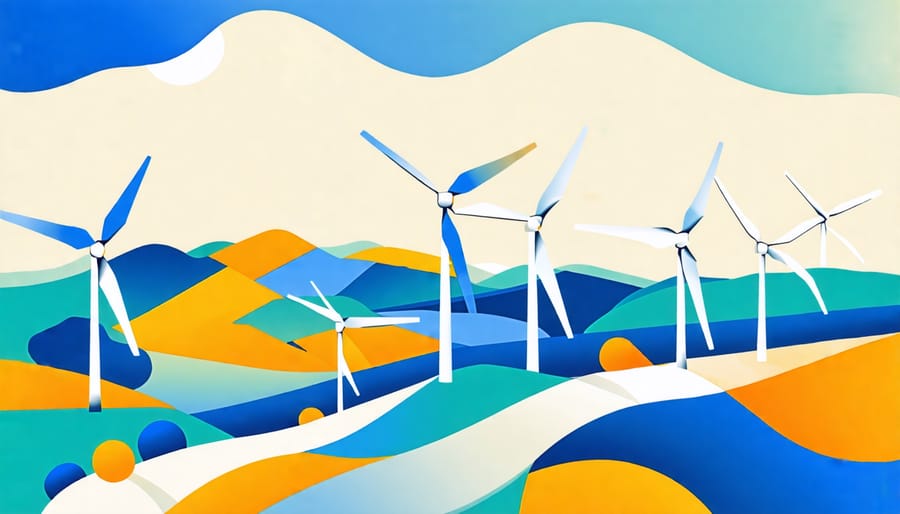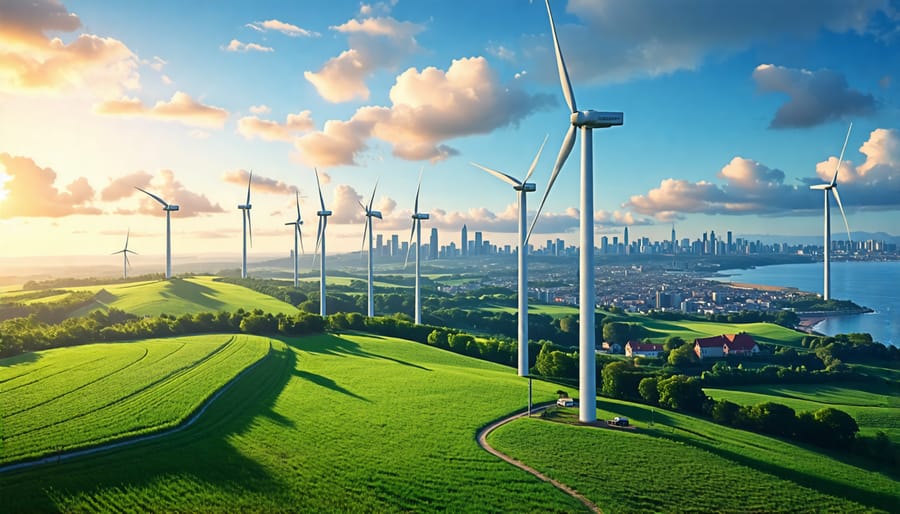Harness the renewable power of wind energy to transform our energy future with these key benefits:
1. Reduce environmental impact by cutting carbon emissions significantly. Wind turbines produce electricity without burning fossil fuels, thus playing a crucial role in combating climate change. Integration of wind farms can shift reliance from carbon-heavy energy sources, promoting a cleaner, healthier environment. Learn more about how the wind power function optimizes this transition.
2. Boost local economies with clean energy investments that create jobs and stimulate financial growth in communities. The wind sector offers diverse employment opportunities, from manufacturing to maintenance, fostering economic resilience while advancing sustainable infrastructure.
3. Enhance energy security by diversifying energy supply and reducing dependence on imported fuels. Wind energy offers a stable, domestically sourced power option that keeps energy prices stable and fortifies national energy independence, offering a sustainable pathway to a secure energy future.
Environmental Benefits of Wind Energy

Reducing Carbon Emissions
Wind energy is a compelling solution for reducing carbon emissions, presenting significant environmental benefits compared to traditional fossil fuels. In a world grappling with climate change, transitioning to renewable energy sources like wind power is crucial. Recent statistics highlight that in 2020 alone, wind energy helped avoid the emission of over 1.2 billion metric tons of carbon dioxide globally, equivalent to the annual emissions of over 258 million cars.
Unlike fossil fuels, wind energy production is inherently clean. Wind turbines harness the power of natural wind currents without releasing pollutants or greenhouse gases during operation. This contrast is stark when compared to coal or natural gas plants, which are significant contributors to CO2 emissions, a leading driver of global warming.
Countries investing heavily in wind energy, such as Denmark and Germany, showcase real-life success stories. Denmark generates nearly half of its electricity from wind, successfully slashing its carbon footprint. As more nations follow this path, wind energy’s potential to curb emissions becomes ever more apparent.
Moreover, advancements in technology are making wind energy more efficient and accessible, opening avenues for widespread adoption. As wind farms continue to expand, they stand as beacons of hope in the quest for sustainable energy solutions that safeguard our planet for future generations.
Preservation of Natural Resources
Wind energy stands out as a crucial ally in the preservation of natural resources, particularly in reducing water usage and conserving land. Unlike conventional power plants that consume vast amounts of water for cooling, wind turbines require no water during operation. This is especially significant in arid regions where water scarcity poses a persistent challenge. A recent study by the International Renewable Energy Agency highlights that wind energy could save billions of gallons of water annually compared to fossil fuel technologies, underscoring the pivotal role of wind power in sustainable water management.
Moreover, wind farms occupy a relatively small physical footprint while allowing land to be used simultaneously for agricultural or grazing purposes. This dual-use capability enables communities to leverage wind energy without displacing existing land uses. For instance, in rural Iowa, farmers have successfully integrated wind turbines into their operations, maintaining agricultural productivity while also generating clean energy. Such practices exemplify how wind energy facilitates harmonious coexistence with natural landscapes.
By mitigating the strain on water resources and promoting efficient land use, wind energy not only addresses immediate ecological concerns but also provides a scalable solution for meeting future energy needs sustainably. This aligns with a broader commitment to safeguarding natural resources for future generations.

Economic Advantages of Wind Power
Cost Savings for Consumers
Wind energy offers a compelling financial advantage by significantly reducing energy bills for consumers. As the price of traditional energy sources remains volatile, harnessing wind can stabilize energy costs, offering budget predictability. According to a recent economic comparison, wind power is now one of the most affordable energy sources available. This drop in cost is primarily due to technological advancements and increasing investment in wind infrastructure, which have collectively driven down production expenses.
For individual consumers, this transition can translate into tangible savings. Homeowners who tap into local wind farms often notice a gradual decline in utility bills. In some regions, consumers also benefit from incentives and rebates when they choose wind energy, further enhancing their savings. Consider the story from a community in Texas, where residents saw their monthly energy expenses decrease by over 20% after switching to wind power.
Moreover, wind energy contributes to a healthier economy by creating jobs and boosting local economies, leading to broader economic benefits. By choosing wind, consumers not only cut their costs but also support a sustainable and prosperous future. This dual benefit makes wind energy a smart and optimistic choice for forward-thinking individuals committed to both savings and sustainability.
Job Creation and Economic Growth
Wind energy is a dynamic force in job creation and economic growth, underscoring its role as a potent engine for sustainable development. This rapid expansion in the sector not only advances environmental goals but also invigorates local economies with employment opportunities. Take, for example, the story of Iowa, where wind energy jobs have dramatically increased, making the state a leader in wind production. According to industry experts, each new wind project generates a surge of local jobs, from manufacturing components to installation and maintenance, effectively broadening employment horizons.
Similarly, in Texas, wind energy has become a significant contributor to the state’s economy, employing thousands in roles ranging from engineering to turbine operation and maintenance. This workforce expansion is supported by comprehensive training programs that equip individuals with the necessary skills, thereby fostering a highly skilled labor pool dedicated to sustaining renewable energy efforts.
Moreover, the economic impact extends beyond direct job creation. Wind farms enhance revenue streams for local communities through land leases and tax payments that fund public services like schools and infrastructure, ensuring long-term economic vitality. By leveraging wind energy, regions across the nation are carving a path towards a prosperous and sustainable future, cementing wind power’s status as more than just a clean energy source but a crucial pillar in economic resilience and growth.
Energy Security and Independence
Stability and Reliability
Wind energy stands out for its remarkable stability and reliability, offering a consistent power supply crucial for energy resilience. Unlike fossil fuels, which are subject to price fluctuations and geopolitical disruptions, wind energy harnesses a free, inexhaustible natural resource. Modern wind turbines are engineered to operate in a wide range of conditions, improving the dependability of wind power across diverse environments.
Real-life examples, such as Denmark and parts of the United States, showcase wind power’s role in maintaining electricity grid stability. These areas experience reduced reliance on non-renewable energy sources, leading to significant strides in energy independence. Moreover, technological advancements in forecasting wind patterns enhance the predictability of power generation, ensuring an uninterrupted energy supply even during variable weather conditions.
With increasing investments and innovations, wind energy continues to solidify its place as a pillar of sustainable and reliable energy systems, making it an appealing option for those dedicated to fostering a greener, more resilient future.
Reducing Dependence on Imports
Wind energy offers a remarkable avenue for reducing dependence on imported fuels, significantly bolstering national energy security. By harnessing the power of the wind, countries can produce electricity locally, minimizing the volatility associated with foreign fuel supply chains. This self-sufficiency not only alleviates the economic burden of fuel imports but also insulates local markets from geopolitical tensions that can disrupt fuel access and lead to unpredictable price fluctuations.
The increased adoption of wind energy can be seen in countries like Denmark, which sources nearly half of its electricity from wind, dramatically cutting fuel import needs. Such strides underscore how transitioning to wind energy can empower nations to control their energy destinies, emphasizing stability and sustainability over vulnerability and dependence. Wind energy’s ability to provide a steady and renewable resource represents a strategic pivot away from finite, often foreign-controlled fuel supplies, paving the way for a more resilient and environmentally friendly energy landscape.
Conclusion
In conclusion, wind energy stands as a pivotal element in the pursuit of a sustainable energy future. Through its numerous environmental benefits, such as reducing greenhouse gas emissions and fostering cleaner air, wind power contributes significantly to combating climate change. Economically, it creates jobs and stimulates local economies, underscoring its potential as a driving force for growth in communities worldwide. Energy security is another vital advantage, as wind energy offers a stable, domestic energy source that reduces reliance on imported fossil fuels. Real-life case studies highlight countries and regions where wind energy integration has led to substantial advancements in sustainability and energy independence. The insights from expert interviews have reinforced the exciting potential for innovation and development in this sector. As renewable energy enthusiasts and policymakers look toward the future, embracing wind energy’s capacities can inspire transformative progress, propelling us toward a world that harmonizes ecological responsibility with economic prosperity.





